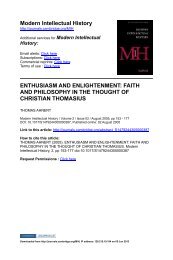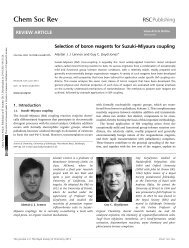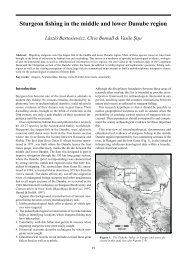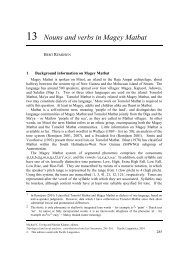Standard Anatomical and Visual Space for the Mouse Retina ...
Standard Anatomical and Visual Space for the Mouse Retina ...
Standard Anatomical and Visual Space for the Mouse Retina ...
You also want an ePaper? Increase the reach of your titles
YUMPU automatically turns print PDFs into web optimized ePapers that Google loves.
Retistruct: Reconstruction of Flat-mount <strong>Retina</strong>edisc location (Figure 4C). If reconstructions require accuracy toless than 7.4u, this could be achieved by increasing <strong>the</strong> stringencyof e L values used to reject reconstructions. Rounding up this errorgives a value of 8u, which is 3.6% of <strong>the</strong> 223u along <strong>the</strong>nasotemporal axis of <strong>the</strong> adult eye. It is worth noting that <strong>the</strong> errorof reconstruction depends not only on <strong>the</strong> algorithm, but also <strong>the</strong>data presented to it, which is intrinsically variable.ResultsFigure 3. De<strong>for</strong>mation of reconstructions <strong>and</strong> <strong>the</strong> effect of rimangle. A, Histogram of <strong>the</strong> reconstruction error measure e L obtainedfrom 288 successfully reconstructed retinae. B, Relationship betweende<strong>for</strong>mation measure <strong>and</strong> age. ‘‘A’’ indicates adult animals. C,Schematic diagram of eye, indicating <strong>the</strong> measurements d e <strong>and</strong> d rmade on mouse eyes at different stages of development, <strong>and</strong> <strong>the</strong> rimangle Q 0 derived from <strong>the</strong>se measurements. Note that rim angle ismeasured from <strong>the</strong> optic pole (*). D, Rim colatitude ^Q 0 that minimisesreconstruction error versus <strong>the</strong> rim angle Q 0 determined from eyemeasurements. Solid line shows equality <strong>and</strong> grey lines indicate 610u<strong>and</strong> 620u from equality. E, Minimum reconstruction error e L obtainedby optimising rim angle versus reconstruction error e L obtained whenusing <strong>the</strong> rim angle from eye measurements. Solid line indicatesequality.doi:10.1371/journal.pcbi.1002921.g003concluded that this improvement was not sufficiently great to addautomatic refinement of <strong>the</strong> rim angle to <strong>the</strong> algorithm.Estimate of errors of <strong>the</strong> reconstruction algorithm fromoptic disc locationThe de<strong>for</strong>mation measure gives an indication of how easy it is tomorph any particular flattened retina onto a partial sphere, but itdoes not indicate <strong>the</strong> error involved in <strong>the</strong> reconstruction, i.e. <strong>the</strong>difference between <strong>the</strong> inferred position on <strong>the</strong> spherical retina<strong>and</strong> <strong>the</strong> original position on <strong>the</strong> spherical retina. The ideal method<strong>for</strong> estimating <strong>the</strong> error would be to flatten a retina marked inknown locations, <strong>and</strong> <strong>the</strong>n compare <strong>the</strong> inferred with <strong>the</strong> knownlocations. However, this proved to be technically very difficult <strong>and</strong>so we tried ano<strong>the</strong>r method of estimating <strong>the</strong> error that uses <strong>the</strong>inferred locations of <strong>the</strong> optic discs across a number of retinae. Inmice, <strong>the</strong> optic disc is located ‘‘ra<strong>the</strong>r precisely in <strong>the</strong> geometriccenter of <strong>the</strong> retina’’ [18], though this has not, as far as we areaware, been measured. We marked <strong>the</strong> optic disc in 72 flatmountedadult retinae, <strong>and</strong> <strong>the</strong> distribution of <strong>the</strong> centres of <strong>the</strong>inferred locations of <strong>the</strong>se optic discs is shown in Figure 4A,B. Themean colatitude <strong>and</strong> longitude of <strong>the</strong>se optic discs is (3.7u, 95.4u)with a st<strong>and</strong>ard deviation of 7.4u. The mean is <strong>the</strong>re<strong>for</strong>e 3.7u awayfrom <strong>the</strong> geometrical centre of <strong>the</strong> retina, in good agreement with<strong>the</strong> qualitative observation that <strong>the</strong> optic disc is at <strong>the</strong> geometriccentre of <strong>the</strong> retina. Under <strong>the</strong>, questionable, assumption thatnone of <strong>the</strong> variability is biological, this suggests that an upperbound on <strong>the</strong> accuracy of <strong>the</strong> reconstruction algorithm is 7.4u.There is a significant relationship between <strong>the</strong> de<strong>for</strong>mation errore L <strong>and</strong> <strong>the</strong> inferred distance of <strong>the</strong> optic disc from <strong>the</strong> mean opticDistributions of ipsilateral <strong>and</strong> contralateral retinalprojectionsWe now describe <strong>the</strong> first application of <strong>the</strong> reconstructionalgorithm. The relationship between <strong>the</strong> projections from <strong>the</strong>mouse retina to <strong>the</strong> ipsilateral <strong>and</strong> contralateral dLGN has beenstudied in retina flat-mounts following injection of retrogradetracer into <strong>the</strong> dLGN [3]. Reconstructing <strong>the</strong> retinae of individualanimals that have had retrograde tracer injected into primaryvisual areas enables comparisons of projection patterns acrossanimals independent of distortions introduced by retinal dissection.Moreover, having a st<strong>and</strong>ard retinal space means that datafrom multiple animals can be used to create aggregate topographicmaps.The reconstruction method has enabled <strong>the</strong> quantification of<strong>the</strong> binocular projection from <strong>the</strong> retina to <strong>the</strong> dLGN acrossmultiple animals. To label <strong>the</strong> projection, <strong>the</strong> dLGN in adult micewas injected ei<strong>the</strong>r with Fluoro-Ruby or Fluoro-Emerald. Fur<strong>the</strong>r,in some animals, <strong>the</strong> injections were bilateral (see Figure 5A <strong>and</strong>Supplemental Materials <strong>and</strong> Methods, Text S1, <strong>for</strong> details). TheRetistruct program was used to reconstruct <strong>the</strong> retinae. The plotsin Figures 5B–D show <strong>the</strong> label in one retina from an animal thathad received bilateral injections into <strong>the</strong> dLGN (Figure 5A). Theseplots were done using an in-house camera-lucida set-up, sampling<strong>the</strong> entire ventrotemporal crescent <strong>for</strong> <strong>the</strong> ipsilateral retina <strong>and</strong>one in nine 150 m square boxes <strong>for</strong> <strong>the</strong> contralateral label(Figure 5B). The ipsilateral projection (Figure 5C) is restricted to<strong>the</strong> ventrotemporal crescent whereas label from <strong>the</strong> contralateralprojection (Figure 5D) is distributed widely. The nature of <strong>the</strong>overlap between <strong>the</strong> uncrossed <strong>and</strong> crossed projections is evidentin Figure 5B. Having reconstructed <strong>the</strong> retinae into a st<strong>and</strong>ardspace, we quantified <strong>the</strong> projection patterns by deriving kerneldensity estimates (KDEs) of <strong>the</strong> underlying probability of datapoints appearing at any point in <strong>the</strong> retina <strong>and</strong> represented <strong>the</strong>seestimates using contours that exclude 5%, 25%, 50% <strong>and</strong> 95% of<strong>the</strong> points (Figure 5C). In <strong>the</strong> case of <strong>the</strong> contralateral label, <strong>the</strong>Figure 4. Estimation of reconstruction error using optic disclocation. A, Inferred positions of optic discs from 72 adultreconstructed retinae plotted on <strong>the</strong> same polar projection. Thecolatitude <strong>and</strong> longitude of <strong>the</strong> Karcher mean is (3.7u, 95.4u). Thest<strong>and</strong>ard deviation in <strong>the</strong> angular displacement from <strong>the</strong> mean is 7.4u.B, The same data plotted on a larger scale. C, The relationship between<strong>the</strong> de<strong>for</strong>mation of <strong>the</strong> reconstruction <strong>and</strong> distance e OD of <strong>the</strong> inferredoptic disc from <strong>the</strong> population mean. There was a significant correlationbetween <strong>the</strong> two (R 2 ~0:35,pv0:01).doi:10.1371/journal.pcbi.1002921.g004PLOS Computational Biology | www.ploscompbiol.org 5 February 2013 | Volume 9 | Issue 2 | e1002921









